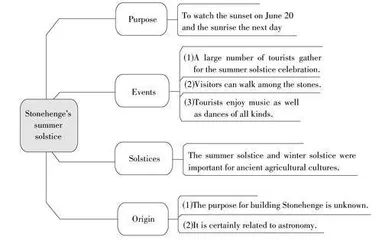Stonehenge's summer solstice夏至日的巨石阵
作者: 孙启禄

1 The summer solstice is Stonehengesbig day. Thousands of people flock to thehuge monument to watch the sunset onJune 20 and the sunrise the next day in anevent that mixes festivity with spirituality.
2 If you are lucky enough to visit Lon⁃don in the summer, specifically in the thirdweek of June, you should not miss the summer solstice celebration held at the nearby monu⁃ment of Stonehenge. Between the 20th and 21st of that month, when the length of theday is the longest of the year, a large number of the British and visitors from othercountries gather on a day that can only be described as magical.
3 On that day, Stonehenge takes on a different dimension that combines festivity withan attempt to recall ancient ceremonies. Visitors can access the complex (建筑群) free ofcharge and will be able to walk among the stones, something not allowed during the rest ofthe year.
4 The summer solstice (between June 20 and 21), occurs at the peak of the day and isperhaps the best time to visit Stonehenge. The other, the winter solstice (December 21⁃22),marks just the opposite event. These days have always had a special significance, as theymark the changing of the seasons, which is important for ancient agricultural cultures. Forthis reason, ceremonies and festivals are held in many parts of the world.
5 One of the many theories about the origin of Stonehenge relates it precisely to thesecelebrations. Although the purpose for which it was built has not yet been discovered, whatis known with certainty is that during the summer solstice the sun rises to the left ofthe Heel Stone and crosses right through the central axis (轴) of the rock complex.
6 The first reaction of anyone arriving from London at Stonehenge on Midsummer'sDay is likely to be one of awe (敬畏). The complex and its surroundings are filled with anatmosphere that perfectly combines festivity and mysticism (神秘). During the night, visi⁃tors can enjoy the music performed by those present, as well as dances of all kinds.
Reading
Check
1. Why do thousands of people crowd around Stonehenge?
A. To see the famous Stonehenge.
B. To figure out how Stonehenge was built.
C. To take part in the summer solstice celebration.
D. To watch the sunrise and the sunset on June 20.
2. What does the fourth paragraph mainly tell us?
A. The exact time of the summer solstice.
B. The best time to pay a visit to Stonehenge.
C. The reason for the ceremonies and festivals.
D. The significance of the summer and winter solstices.
3. What can we infer about the construction of Stonehenge from the text?
A. It might be built for ancient ceremonies.
B. It might be built to celebrate the harvest.
C. It must have been related to astronomy.
D. It must have been built between the two solstices.
Ⅱ. 语句分析
Between the 20th and 21st of that month, when the length of the day is the longest ofthe year, a large number of the British and visitors from other countries gather on a day thatcan only be described as magical. 在那个月20日至21日,白昼时间在这个时候达到最长,很多英国人和来自其他国家的游客在这一天聚集在一起。这一天只能用神奇来形容。
【点石成金】本句是一个复合句。a large number of the British and visitors fromother countries gather...是主句,Between...of that month 是介词短语作时间状语,whenthe length...the year是非限制性定语从句,that can...as magical是限制性定语从句。
Ø 语言运用
Ⅰ. 例句仿写
在一年前除了废墟什么都没有的地方出现了许多高楼。(a number of)__________________where there was nothing a year ago but ruins.
Ⅱ. 写作实践
假定你是李华,你对巨石阵的夏至日庆典非常感兴趣,请你给家在伦敦的朋友John写一封邮件,请他详细介绍一下庆典。要点如下:
1. 表明写信的目的;
2. 你希望了解的内容;
3. 表达谢意。
注意:
1. 词数80左右;
2. 可以适当增加细节,以使行文连贯。
Dear John,_______________________________________
Yours,
Li Hua